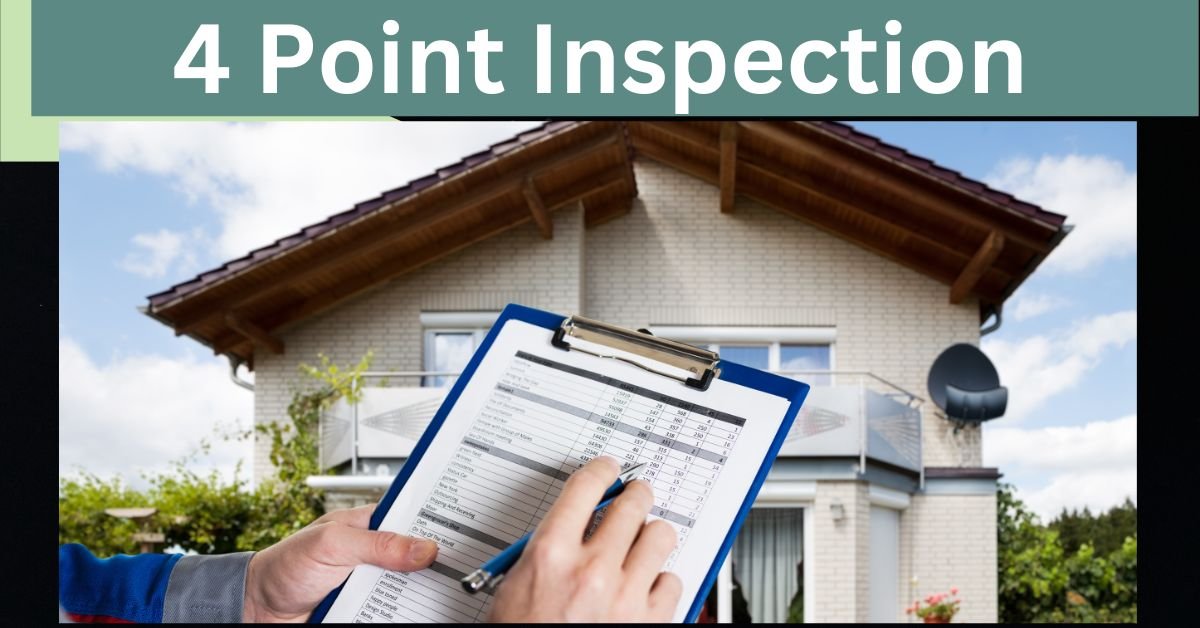Insurance 4-point inspection provides homeowners insurance companies with critical insights into the condition of a house by evaluating its four key systems: roofing, electrical, plumbing, and HVAC (heating, ventilation, and air conditioning). The results of this inspection help insurance providers assess the level of liability they would take on if they offer coverage for the home.
In this article, we’ll explore the details of a Insurance 4-point inspection, how to prepare for it, and how it differs from a full home inspection.
Table of Contents
What Is a Insurance 4-Point Inspection?
Insurance 4-point inspection assesses the following systems in a home or condominium:
- Roofing
- Electrical
- Plumbing
- HVAC
A professional home inspector evaluates the functionality and condition of these systems to determine if they are working properly or need repairs or replacement. Homeowners insurance companies often require a 4-point inspection, especially for homes over four years old, before approving or renewing a policy. This is because older homes are more prone to significant repairs.
For example, if someone is seeking coverage for a home that is five years old, there may already be issues with the electrical or HVAC systems that could become problematic in the near future. By examining these key systems, insurers can better understand the risk of insuring a particular property and plan accordingly.
For potential homebuyers, a 4-point inspection can also provide valuable insight into the home’s condition before committing to a purchase, helping avoid costly future repairs.
Benefits of a Insurance 4-Point Inspection
A 4-point inspection offers several advantages for both current and prospective homeowners:
- Quick and Affordable: A 4-point inspection can typically be completed in a matter of hours and at a low cost.
- Improves Property Condition: Sellers can use the inspection to identify areas that need attention before listing their home, making the property more appealing to buyers.
- Prevents Future Surprises: For buyers, this inspection helps prevent unexpected issues, reducing the chance of having to make costly repairs shortly after purchase.
What Does a Insurance 4-Point Inspection Cover?
Here’s a closer look at the four major systems covered during a 4-point inspection:
1. HVAC (Heating, Ventilation, and Air Conditioning)
The HVAC system regulates the climate within a home. An inspector will assess the system’s efficiency, look for visible signs of wear or leaks, and check that both hot and cold air are flowing correctly through the vents.
- Fully Operational Systems: Central heating and cooling systems must be fully functional. Fireplaces, window units, and oil furnaces are not considered acceptable as primary heating or cooling systems due to safety concerns.
- Condition and Age: While not always a deciding factor, the age of the HVAC unit will be noted. If it’s over 20 years old, it may be recommended for replacement.
2. Electrical Panels and Wiring
Inspectors check that electrical systems are up to code and safe. This includes ensuring outlets are properly grounded and that the electrical capacity is suitable for the home’s size.
Certain types of wiring or panels, such as aluminum branch wiring, knob-and-tube wiring, or fuse boxes, are seen as fire hazards and can cause the home to fail the inspection. Upgrades may be necessary for safety and to pass the inspection.
3. Plumbing
Plumbing inspections involve checking the material and condition of the home’s pipes and looking for any signs of leakage or deterioration. Inspectors will also evaluate the water heater to ensure it’s distributing water effectively.
4. Roofing
The roof is one of the most crucial parts of a home’s structure. An inspector will assess the roof’s age, condition, and material, looking for signs of wear, leaks, or damage. If the roof is older than 20 years or shows significant deterioration, it may need to be replaced to pass the inspection.
Preparing for a Insurance 4-Point Inspection
To prepare for a Insurance 4-point inspection, homeowners should address any visible issues within the four systems. Some tips include:
- Check HVAC: Ensure that both heating and cooling systems are functioning properly. If your home relies on outdated systems, consider upgrading.
- Inspect Wiring: Look for exposed, ungrounded, or outdated wiring. These are often seen as fire risks and may need to be replaced.
- Check for Leaks: Examine pipes for signs of leakage or water damage, which could disqualify you from obtaining insurance.
- Inspect Roof: Repair any broken or missing shingles and address any areas of water damage.
Insurance 4-Point Inspection vs. Full Home Inspection
While a Insurance 4-point inspection focuses on four major systems, a full home inspection is a more comprehensive evaluation of the entire home. Here’s a breakdown of the key differences:
- Scope: Insurance 4-point inspection only covers roofing, electrical, plumbing, and HVAC, while a full inspection assesses additional aspects like the home’s structure, drainage, windows, and appliances.
- Purpose: Insurance 4-point inspections are usually required by insurance companies for older homes, whereas a full inspection is typically requested by homebuyers to fully assess a home’s condition.
- Insurance Requirements: Many insurers require a Insurance 4-point inspection for homes over 30 years old. Full home inspections, however, are not required by insurers but are an important step for homebuyers.
Cost of a Insurance 4-Point Inspection
The cost of a Insurance 4-point inspection can vary depending on location and the insurance provider, but it typically ranges between $50 and $150.
Conclusion
Insurance 4-point inspection can be a valuable tool for both homeowners and buyers. Whether you’re renewing your insurance or buying an older home, this inspection helps ensure that the property is in good condition and that insurers view it as a reasonable risk.
Before scheduling an inspection, make sure your financing is in place, so you can move forward confidently with your home purchase.
Checkout more News

